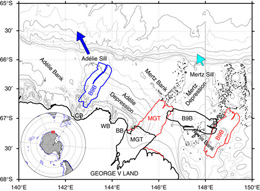Research Abstract
メルツ氷河崩壊後に海氷生産量が減少するレジームシフトが起きた可能性
Potential regime shift in decreased sea ice production after the Mertz Glacier calving
2012年5月8日 Nature Communications 3 : 826 doi: 10.1038/ncomms1820

高密度陸棚水形成量の変動は、全球気候システムの主要な成分である南極低層水生成に影響を及ぼす可能性がある。東南極のジョージ5世ランドポリニヤシステム(東経142-150度)はローカルな氷の状況(沿岸線)によって形成され、継続的な沖向きの風により駆動される海氷形成を促進している。本論文では、2010年にメルツ氷舌が分離・崩壊したことにより巨大な氷山(B9B)が移動した後、初めてこの地域を観測した結果を提示する。人工衛星データを用いた結果から、2010年と2011年のこの地域における海氷の総生産量はそれぞれ144と134 km3であり、2000-2009年の平均値である168 km3から14-20%の減少となっていることがわかった。ローカルな氷況に対応するこの急激な変化は、今後数十年間にわたってこの地域において、ポリニヤの活動、海氷生産量の減少、最終的には高密度陸棚水および南極底層水の流出量の減少が起こるという結果をもたらす可能性がある。
- 国立極地研究所
- タスマニア大学 南極気候生態学共同研究センター(オーストラリア)
- 北海道大学低温科学研究所
Variability in dense shelf water formation can potentially impact Antarctic Bottom Water (AABW) production, a vital component of the global climate system. In East Antarctica, the George V Land polynya system (142–150°E) is structured by the local 'icescape', promoting sea ice formation that is driven by the offshore wind regime. Here we present the first observations of this region after the repositioning of a large iceberg (B9B) precipitated the calving of the Mertz Glacier Tongue in 2010. Using satellite data, we find that the total sea ice production for the region in 2010 and 2011 was 144 and 134 km3, respectively, representing a 14–20% decrease from a value of 168 km3 averaged from 2000–2009. This abrupt change to the regional icescape could result in decreased polynya activity, sea ice production, and ultimately the dense shelf water export and AABW production from this region for the coming decades.

